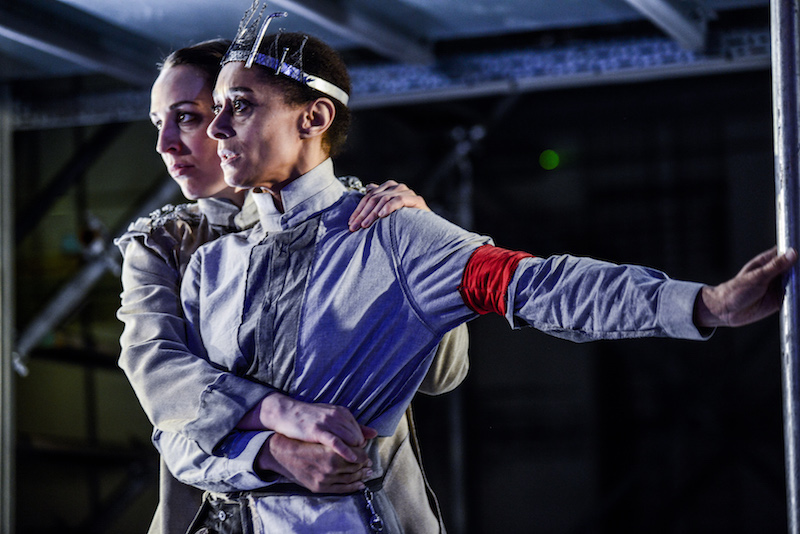Wales Millennium Centre, Cardiff; 10th February 2016

This stunning production of Shakespeare’s three Henry VI plays, merged into one rich adaptation, brings the terror of civil war to the industrial void space of the Wales Millennium Centre through a veil of chilling beauty. Omidaze Productions presented an all-female Richard III here last year, and now return with the prequel. We see the women on stage like ghosts of all the wars that have been and will be, the innocent victims who suffer because of the actions of others, whilst today they also play the parts that tell of England’s own bloody War of the Roses.

King Henry himself is Hannah O’Leary, that rare gift of a professional aerialist who is also a classically trained actor (full disclosure: we were in the same graduating class from drama school). Her shroud-like drapes of silk, adrift throughout the promenade space of steel and foiled air-conditioning pipes, are used to show Henry VI as a distracted and playful child-king, later engaged more with the business of heaven and spiritual contemplation than with the earthly quarrels and jealousies of those who plot beneath him.
Circus direction is from Paul Evans, who has a history of practical research into the use of voice within aerial work (which Hannah has also been involved with). Here, the strength needed to speak Shakespearean lines from positions of physical tension is combined with a release method that causes involuntary inflection when required for heightened emotional emphasis. Drops are timed to coincide with parts of speech where psychological impact could naturally cause a break in the voice, meaning the force exerted on the body produces a momentary physical waver in control that reinforces the emotional impact. Henry’s most powerful emotions though, are revealed when forced to ground, out of the comfort of his aerial-induced dislocation from worldly events.
 As these events unfold, we are guided under scaffolding and between white painted concrete pillars. A performer’s wafting arm or blockaded path halts and switches our direction, or a lighting change and fleeing cast entice us to follow. As we float from scene to scene, we’re reminded of our presence by the characters’ insinuating eye-contact – enlisting us, persuading us of their cause as they speak – and by the mirrors cunningly set as part of Gabriella Slade’s design to increase the sense of gathered crowds.
As these events unfold, we are guided under scaffolding and between white painted concrete pillars. A performer’s wafting arm or blockaded path halts and switches our direction, or a lighting change and fleeing cast entice us to follow. As we float from scene to scene, we’re reminded of our presence by the characters’ insinuating eye-contact – enlisting us, persuading us of their cause as they speak – and by the mirrors cunningly set as part of Gabriella Slade’s design to increase the sense of gathered crowds.
 Along the corridors and up the narrow maintenance stairs that lead us to the 8th storey roof cavity the spectral figures haunt, is further evidence of Slade’s hand. Timelines, marking Shakespeare’s history, that of the English kings, and events leading to and from the 15th Century war are hand-scrawled on masking tape or the whitewashed walls, reminding us before we even enter the space of the layers and layers of repeated war-hunger in human history. The pale costumes too are layered on and off of a universal grey under-uniform, to mark the ever flowing rota of jealous, greedy, corrupt or betrayed men portrayed by the ground-based ensemble of seven women.
Along the corridors and up the narrow maintenance stairs that lead us to the 8th storey roof cavity the spectral figures haunt, is further evidence of Slade’s hand. Timelines, marking Shakespeare’s history, that of the English kings, and events leading to and from the 15th Century war are hand-scrawled on masking tape or the whitewashed walls, reminding us before we even enter the space of the layers and layers of repeated war-hunger in human history. The pale costumes too are layered on and off of a universal grey under-uniform, to mark the ever flowing rota of jealous, greedy, corrupt or betrayed men portrayed by the ground-based ensemble of seven women.
There is nothing pale about the textual delivery, however, or the edit by director Yvonne Murphy, which allows us to clearly follow the sequence of political and personal events surrounding Henry’s rule. When the lineage that leads to the contention over the crown is revealed by Richard Duke of York (Sioned Jones, bear-like as the younger Richard later describes), walls are used again to draw out the family tree and add clarity to a list of names easily forgotten.

Our immediate use of the space – including the stripping of builders’ tape from a sealed off alcove to denote the red and white roses that separate the Lancaster and York factions – is layered with sounds of grinding industrial machinery that seem to come from the building’s past, and futuristic silvers and shivering bass, creating a palimpsest of all-times that give a four hundred year old play haunting currency for today, and all days.
Ending with the first lines of Richard III is, presumably, a nod to the company’s last production here, but also serves as a reminder that civil war doesn’t end with catharsis for anyone. The inevitable continuation of those ‘fatal instruments of war’ – mankind – is waiting, just beyond the present moment we’re caught in.






[…] Yvonne Murphy’s trilogy for Omidaze. Unlike the previous productions of Richard III and Henry VI, however, Romeo & Juliet moves the overt focus from the politics themselves to the impact […]